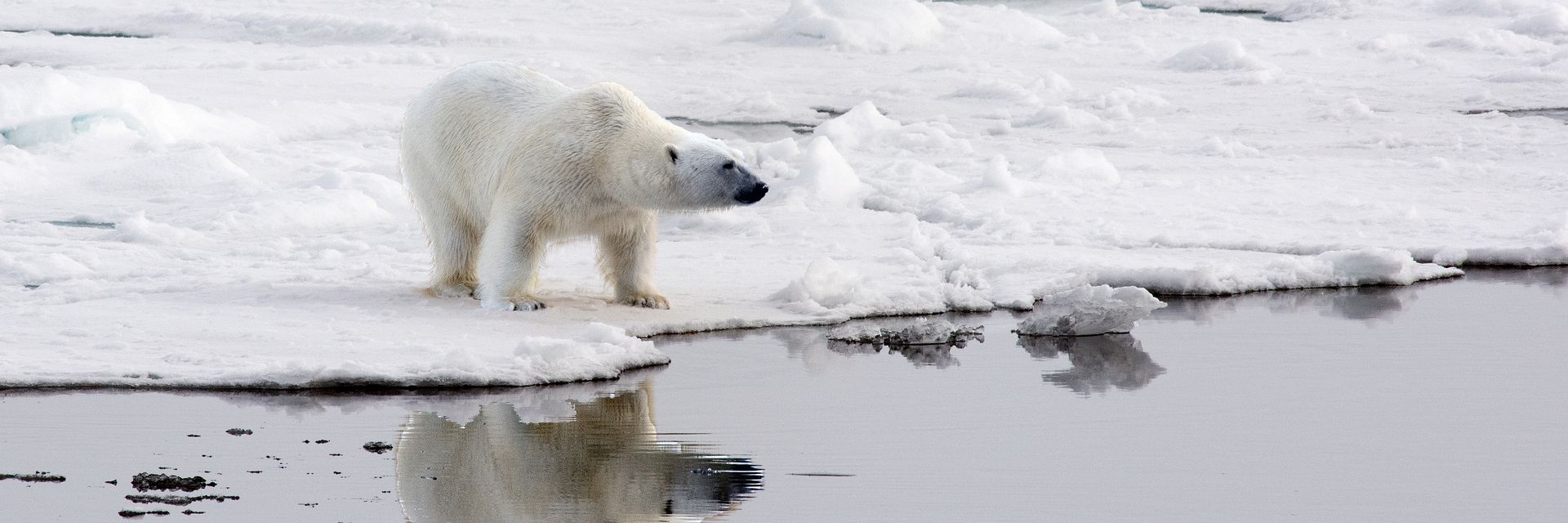The Arctic’s vibrant ecosystem of seals and narwhals is a feeding ground for polar bears, the apex predator in the region. With a diet sustained by underwater creatures, where do polar bears live and what does their future look like?
◊
From above, the Arctic is defined by jagged sections of white ice contrasting with the deep blue of chilled oceans. It’s as barren as a sandy desert, uninhabitable for humans and consequently lacking the characteristic traces of our presence. Every now and then, a moving white figure, almost invisible against the ice, might cast a shadow, leaving miles of pawprints in its wake. Polar bears reign supreme in the circumpolar North and leave their mark on their habitat, but the changing conditions of the Arctic are having an alarming impact on where polar bears can survive.
To learn more about the Arctic and the polar bears that roam through it, check out Fascinating Places: A Summer with Polar Bears at Hudson Bay.
Where Do Polar Bears Live?
The North Pole is identifiable on nearly every map or globe, but if you actually were to visit the region, you would have to wander panels of ice until your compass spun circles around itself. While Antarctica is a distinguishable continent centered around the South Pole, the Arctic reaches into eight different countries on three continents.
This is the home of the polar bear, the uncontested monarch of the Arctic. Found roaming the shorelines of Alaska or wandering the fjords of Greenland, they are apex predators whose domain transcends the borders of countries.
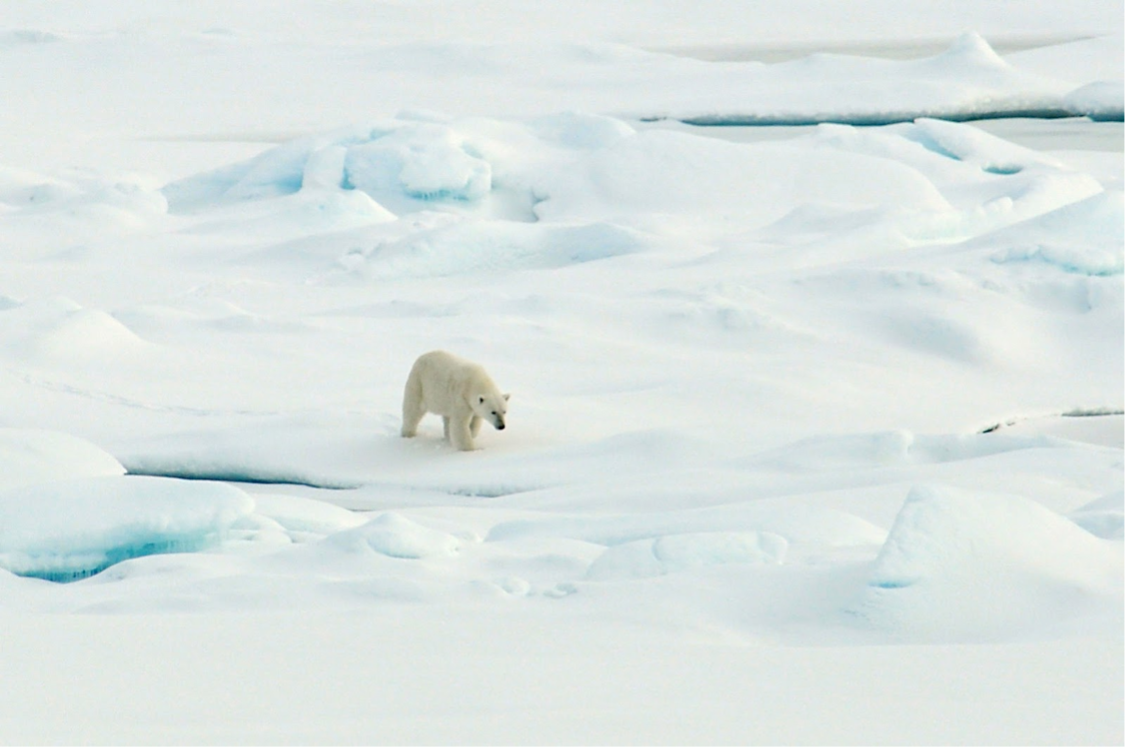
A polar bear walking on the Arctic Ocean ice (Credit: Patrick Kelley, U.S. Coast Guard, via U.S. Geological Survey)
Wherever Food is Plentiful
With one of the most extreme climates on Earth, the Arctic is an unforgiving environment that offers little stability in its temperatures or even its geographic makeup, forcing marine mammals to follow food. They crave blubbery animals like seals, walruses, and narwhals for meals, as fatty meat is the quickest to break down and provides a highly concentrated load of calories. While these prey animals have traditionally been non-migratory species, they do travel hundreds of miles to find their own food – which means that polar bears looking to eat them must do the same.
Polar bears don’t have territories in the way that other top predators, such as Arctic wolves, do. Instead, they are nomads that spend much of their lives alone. This is in part due to the scarcity of prey in the Arctic and the massive quantity of food any polar bear needs to survive. A polar bear is capable of consuming 100 pounds of seal blubber at once, but not every day in the Arctic Circle results in such a bountiful feast. So, to bulk up and protect their organs in temperatures that can drop to -58 degrees Fahrenheit (-50 Celsius), polar bears need to stay almost continuously on the move in search of their next meal.
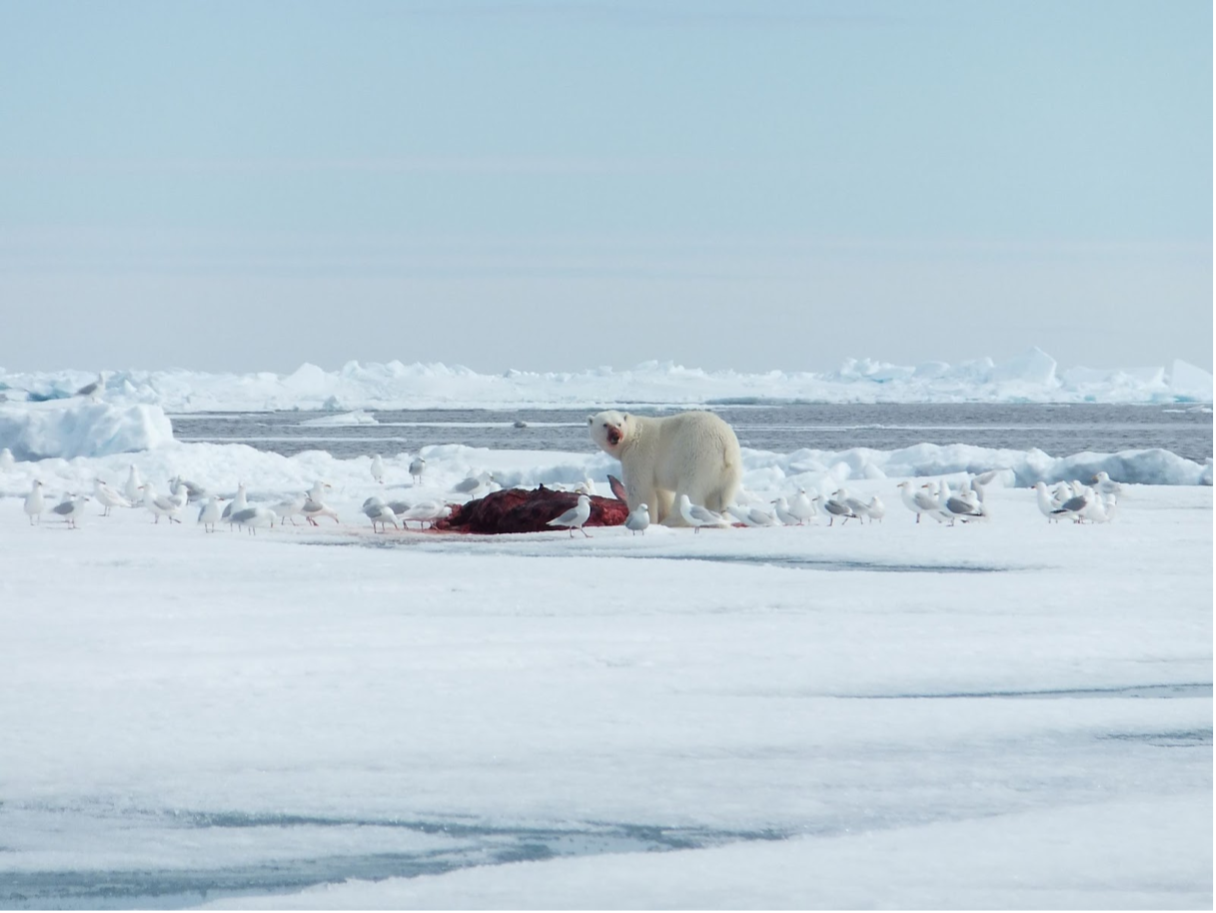
Polar bear feeding offshore from Baffin Island near Sirmilik National Park (Credit: Paul Gierszewski, via Wikimedia Commons)
Where Their Bodies Can Thrive
Weighing up to 1,500 lbs., with males reaching a length of over ten feet, polar bears have massive bodies insulated by a thick, four-inch layer of fat. Their double-layered coats pack in plush, black hairs close to their bodies that trap heat, while translucent tube-like fur on the outer coat traps air for additional insulation. Despite their thick coats, the extreme temperatures and winds of the Arctic can cause polar bears to lose 75 percent of the metabolic heat they produce. To regulate their body temperatures, polar bears have adapted their energy consumption rates and fat reserves. For this reason, polar bears do not hibernate.
Polar bears sleep between seven and eight hours a day. They are also very fond of naps, and dig shallow pits in which to nestle with their backs towards the wind.
Lying still for months at a time would be counterproductive for polar bears, whose survival is dependent on adapting to changing patterns of prey and ice flow. While, like hibernating species, polar bears do have the ability to fast for long periods, their survival depends on staying active. Scientists recently discovered that unique adaptations related to cellular respiration could contribute to the different evolutionary tracks taken by polar bears compared to other members of the Ursidae family.
Wherever the Ice Flows
At the poles, daylight lasts as long as 24 hours in the summer thanks to the “Midnight Sun,” while the winter enshrouds the Arctic in darkness from October until March. Every summer, some portion of ice that comprises polar bears’ optimal hunting environment melts. Since the late 1970s, scientists have used satellite imagery to detect changes to both Arctic and Antarctic sea ice cover, correlating the data to increased levels of carbon dioxide and warming sea temperatures. A comparison of sea ice loss year to year indicates that the extent of sea ice in the Arctic has decreased and that the ice cover itself is thinning. This has a direct impact on the apex predators that rely on this ice for hunting.
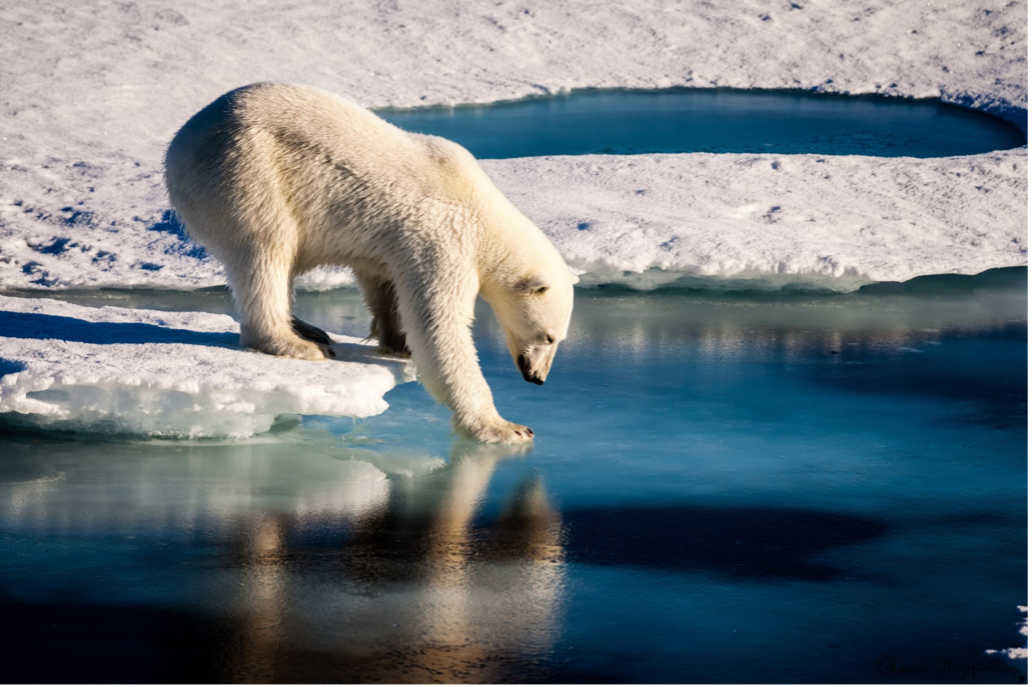
(Credit: Mario Hoppmann/ NASA Goddard)
Hotspots for polar bear activity have been identified in the Svalbard Archipelago, which provides stable ground for their habitat, and along the marginal ice zones in the far North. These zones, which are dynamic regions of sea ice between the Arctic’s pack ice and the floes that vary thanks to seasonal changes, are a tricky habitat for the bears. Shifts in the amount of sea ice year to year reduce the desirable surface area and disrupt the bears’ hunting patterns.
Wherever They Can Be Alone
Except when a mother is raising her cubs, polar bears are rarely spotted in proximity to one another. With studies of climate change in the Arctic region reflecting a long-term decrease in sea ice extent, polar bears are doing as they have always done – adapting. Hunting on ice floes is desirable, but polar bears have altered their migration patterns to follow their food, which means transitioning to hunt on terrestrial coastlines where seals bask.
By 2040, researchers predict that 50 to 88 percent of polar bears will spend upwards of three months on shore. As they spend more time on land, they have begun incorporating new food into their diet. The trickle-down effect of polar bears eating birds, eggs, and plants has an immediate effect on the population of and resources available to the ecosystem. The altered migratory patterns and diminished surface on which to hunt have increased competition among polar bears as well.
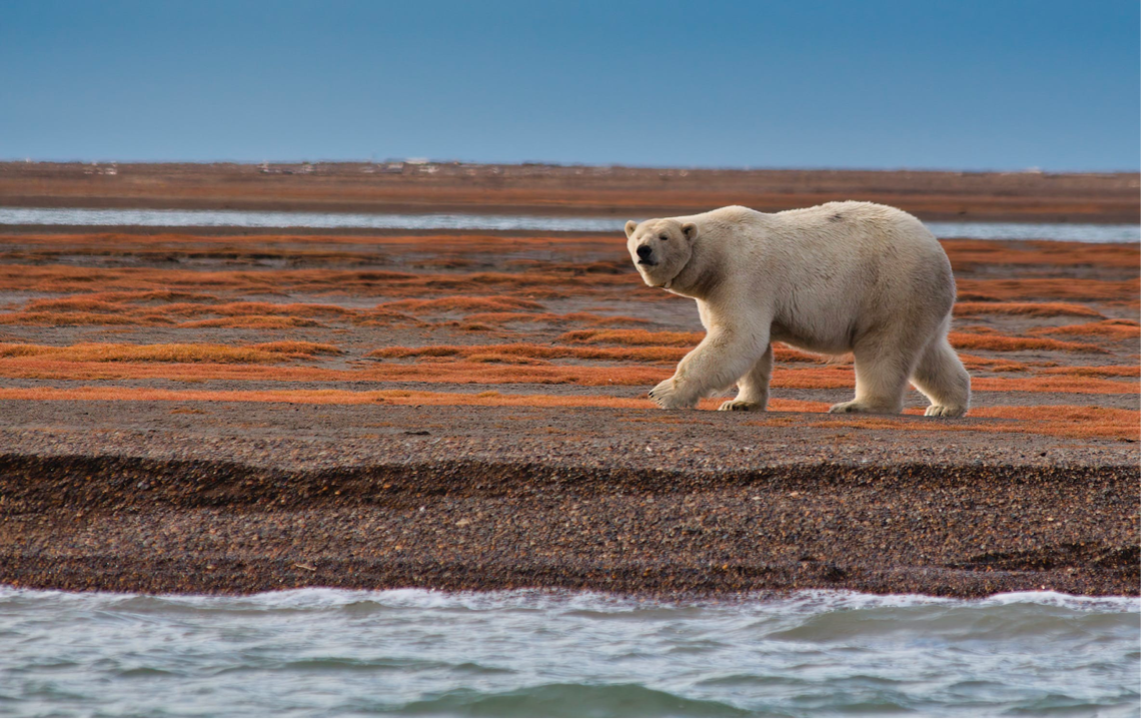
Polar bear on dry land in search of prey (Credit: Dick Hoskins, via Pexels)
What’s Next for Polar Bears?
Scientific studies and data compilation offer us insight into the current state of polar bears’ behavior and give us models to predict the future of how these mammals might adapt to climate change in the Arctic. Polar bears have been looked to as indicators of climate change by researchers, journalists, and storytellers, in part due to their integral role in the Arctic food chain, but also because their role as masters of an extreme environment inspires wonder. Their unique diet and anatomy reflect over 100,000 years of evolutionary adaptations, but the rapid changes they have adopted in the past few decades make the status of polar bears a perfect synecdoche for the state of the Arctic.
As Cultural Icons
When Admiral Robert Peary returned home from an Arctic Expedition in 1909 with claims he had been the first man to reach the North Pole, decades of fascination with the Arctic reached a peak. By venturing into the unknown recesses of the world’s most extreme environment, Peary had photographs and journal entries that ushered in a new era of interest in exploration and adventure. A byproduct of this interest involved bringing back artifacts, including polar bear carcasses. Countless natural history museums and academic centers still feature taxidermied bears that have contributed to efforts to protect the creatures.
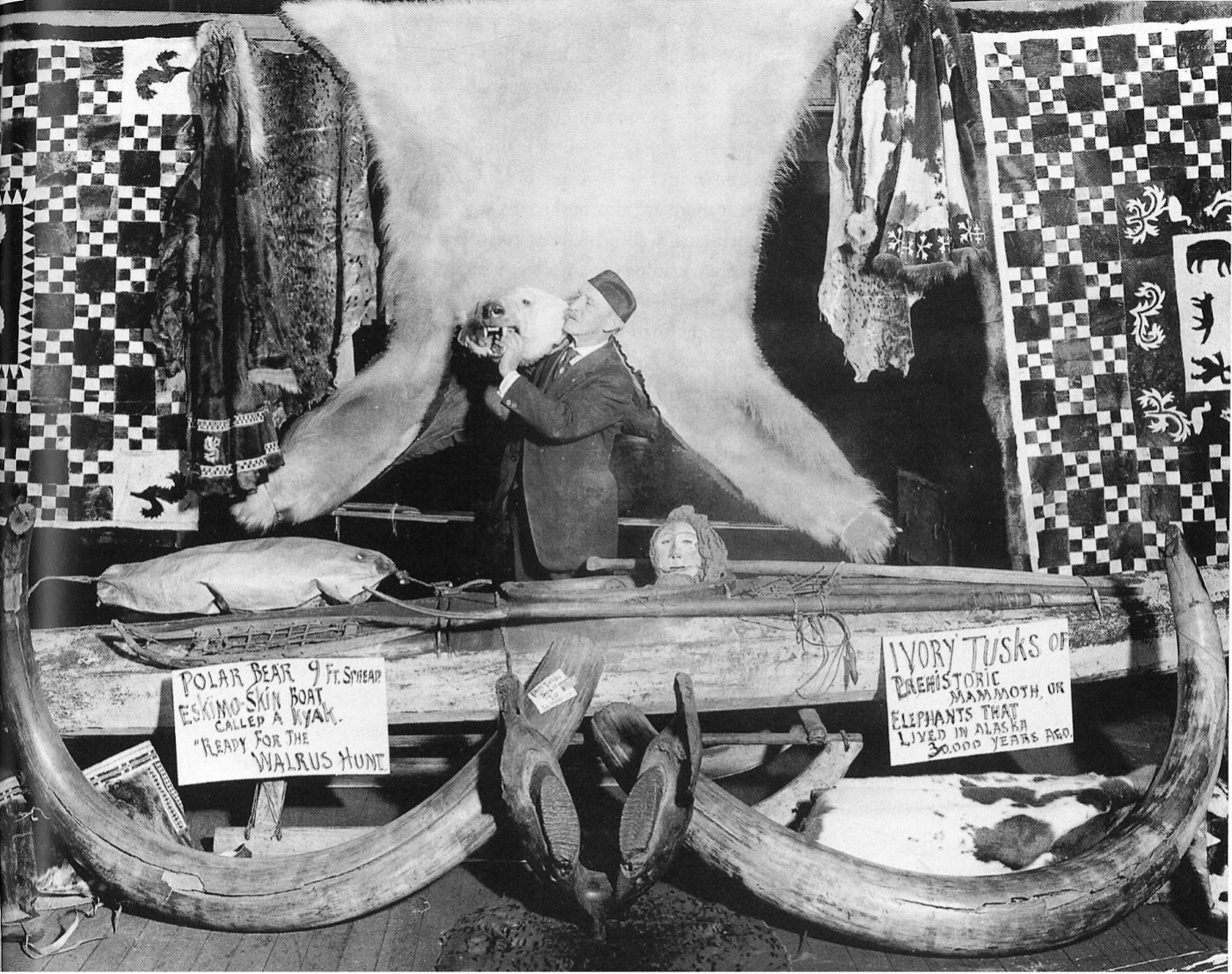
Postcard dating from 1917 featuring a polar bear rug at Ye Olde Curiosity Shop (Source: Public domain, via Wikimedia Commons)
Under Protection of Governments Worldwide
The United States Congress passed the Marine Mammal Protection Act in 1972 to protect polar bears and other animals from being “taken” and prohibited their importation into the country. Four years later, Canada, Denmark, Norway, and the Soviet Union met to coordinate the Agreement on the Conservation of Polar Bears to provide legal protection for them. Currently, polar bears are considered to be a vulnerable species, meaning they are not yet endangered but are still under threat of extinction.
According to Scientists
Climate change has been a source of disagreement and political polarization for decades. Scientific evidence indicates that a decrease in sea ice relates to the polar bears’ increased presence on terrestrial spaces and the resulting changes in their diet. Using remote data collection processes with satellites and artificial intelligence, scientists are looking to capture as much data as possible to understand the state of polar bears while limiting their interactions with human beings in the process. Though the exact number of polars today is unknown, estimates range from 16,000 to 35,000 – and comparisons to population numbers from decades ago are equally uncertain.
However its image is used in politicized discussions about climate change or to attract funding for research or protective measures, there is no denying the awe-inspiring presence that a polar bear has when outlined against its barren, icy domain. Humans may revere polar bears, but their move closer to us is a sign that climate change is having a clear and present effect and that the bears’ habitat is in danger. This is a compelling reminder that the Arctic is as worthy of our concern and respect as our own, less extreme habitats.
Ω
Daisy Dow is a contributing writer for MagellanTV. She also writes for Local Life magazine. Originally from Georgia, she went to college to study philosophy and studio art. She now works in Chicago as a local media specialist.
Title Image: Polar bear at the North Pole (Credit: Christopher Michel, via Wikimedia Commons)
